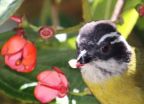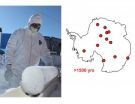(Press-News.org) The genus Axinaea belongs to the large, mainly tropical flowering plant family Melastomataceae (Meadow Beauty Family). Most of the ca. 5000 species in the family rely on bees for their pollination. Only about 100 are known to be pollinated by other insects or vertebrates. The flowers of Axinaea appear in clusters of few to more than twenty flowers and the petals of the different species are pink, yellow, orange or red. The stamens (male reproductive organs) stand out based on the contrasting colours of their bulbous appendages. The pollination mechanism of Axinaea had never been studied before and the researchers (Agnes Dellinger, Yannick Staedler, Jürg Schönenberger (Department of Botany and Biodiversity Research), Lena Fragner, Wolfram Weckwerth (Department of Ecogenomics and Systems Biology) from the University of Vienna, and the California Academy of Sciences (Darin Penneys) were very surprised to find that the flowers of this genus are visited by birds (mainly tanagers).
Complex "bellows" organ
Even more surprising was the finding that the birds do not feed on nectar as in most other bird-pollinated plants but consume the male reproductive organs (the stamens) while visiting the flowers. It turns out that the birds are attracted to the flowers by the conspicuous and sugar-rich stamen-appendages of Axinaea. As the birds seize a stamen, they are blasted with pollen by the stamen's complex "bellows" organ. And as the birds forage on, they deposit some of the pollen on a female floral organ (the stigma) and thus pollinate the flower.
Nutritious, sugar-rich food bodies as reward
Combining video monitoring and pollination experiments in the field with lab-based analyses of stamen structure and chemical composition, the researchers could describe the unique and highly complex pollination mechanism of Axinaea in detail. What they found is completely new to science and differs distinctly from known bird pollination systems. While the majority of bird-pollinated flowers offer nectar as reward, Axinaea attracts the birds with its nutritious, sugar-rich food bodies. In the rare known cases involving food bodies in bird pollinated systems, these rewards are restricted to the sterile outer floral organs. Also, there is no other known case of bird-pollinated plants that involves anatomically distinct bellows-organ for pollen dispersal.
At the more general level of the evolutionary history of flowering plant pollination, this study on the pollination biology of Axinaea provides another example for an evolutionary pollinator shift from bees to birds that is accompanied by conspicuous changes in floral morphology. Such evolutionary shifts from bees to birds or other vertebrates are often correlated with growth at higher altitudes and apparently support an earlier hypothesis postulating that vertebrates may be more reliable and more efficient pollinators at higher elevations than bees.
INFORMATION:
Publication in Current Biology:
Dellinger et al.: "A specialized bird pollination system involving a bellows mechanism for pollen transfer and staminal food body rewards" in Current Biology - July 21, 2014 issue.
DOI: 10.1016/j.cub.2014.05.056
Scientific Contact
MSc. Agnes Dellinger
Department of Botany and
Biodiversity Research
University of Vienna
1030 Vienna, Rennweg 14
T +43-1-4277-540 83
agnes.dellinger@univie.ac.at
Univ.-Prof. Dr. Jürg Schönenberger
Department of Botany and
Biodiversity Research
University of Vienna
1030 Vienna, Rennweg 14
T +43-1-4277-540 80
juerg.schoenenberger@univie.ac.at
Press Contact:
Mag. Alexandra Frey
Press Office
University of Vienna
1010 Vienna, Universitätsring 1
T +43-1-4277-175 33
M +43-664-602 77-175 33
alexandra.frey@univie.ac.at
The University of Vienna, founded in 1365, is one of the oldest and largest universities in Europe. About 9,500 employees, 6,700 of who are academic employees, work at 15 faculties and four centres. This makes the University of Vienna Austria's largest research and education institution. About 92,000 national and international students are currently enrolled at the University of Vienna. With more than 180 degree programmes, the University offers the most diverse range of studies in Austria. The University of Vienna is also a major provider of continuing education. In 2015, the Alma Mater Rudolphina Vindobonensis celebrates its 650th Anniversary. http://www.univie.ac.at
Novel type of bird pollination mechanism discovered in South America
2014-07-07
ELSE PRESS RELEASES FROM THIS DATE:
Pseudogenes may provide clearer understanding of biomarkers
2014-07-07
Alas, the thankless pseudogene.
Dysfunctional, unloved and seemingly of little use, these poor-cousin relatives of genes have lost their protein-coding abilities. They contain material not essential for an organism's survival and are the "last stop" for removal of genomic waste.
Not any more. The pseudogene's day may have arrived thanks to scientists at The University of Texas MD Anderson Cancer Center in Houston.
Han Liang, Ph.D., an assistant professor in the Department of Bioinformatics and Computational Biology at the Cancer Center is advancing knowledge of these ...
NYU researchers find 18 percent of high school seniors smoke hookah
2014-07-07
New York, NY – July 7, 2014 - While cigarette use is declining precipitously among youth, evidence indicates that American adolescents are turning to ethnically-linked alternative tobacco products, such as hookahs, cigars, and various smokeless tobacco products, according to a recent report from the Centers for Disease Control and Prevention (CDC).
Now a new study by researchers affiliated with New York University's Center for Drug Use and HIV Research (CDUHR), in the August 2014 edition of Pediatrics identifies how prevalent Hookah use is and which teens are most likely ...
Denali duck-billed dino tracks
2014-07-07
Boulder, Colo., USA – A trio of paleontologists has discovered a remarkable new tracksite in Alaska's Denali National Park filled with duck-billed dinosaur footprints -- technically referred to as hadrosaurs -- that demonstrates they not only lived in multi-generational herds but thrived in the ancient high-latitude, polar ecosystem. The paper provides new insight into the herd structure and paleobiology of northern polar dinosaurs in an arctic greenhouse world.
The article, "Herd structure in Late Cretaceous polar dinosaurs: A remarkable new dinosaur tracksite, Denali ...
Babies born to healthy mums worldwide are strikingly similar in size
2014-07-07
Babies' growth in the womb and their size at birth, especially their length, are strikingly similar the world over – when babies are born to healthy, well-educated and well-nourished mothers.
That's the finding of a landmark international study, INTERGROWTH-21st, led by Oxford University researchers, which involved almost 60,000 pregnancies in eight defined urban areas in Brazil, China, India, Italy, Kenya, Oman, the UK and USA.
Worldwide there are wide disparities in the average size of babies at birth. This has significant consequences for future health, as small ...
Researchers uncover new knowledge about our intestines
2014-07-06
Researchers from DTU Systems Biology have mapped 500 previously unknown microorganisms in human intestinal flora as well as 800 also unknown bacterial viruses (also called bacteriophages) which attack intestinal bacteria.
To map the microorganisms, the researchers have developed a new principle for analysing DNA sequence data, which they have named the co-abundance principle. A principle which basically assumes that different pieces of DNA from the same organism will occur in the same amount in a sample, and that this amount will vary over a series of samples.
"Using ...
'Nanojuice' could improve how doctors examine the gut
2014-07-06
BUFFALO, N.Y. – Located deep in the human gut, the small intestine is not easy to examine. X-rays, MRIs and ultrasound images provide snapshots but each suffers limitations.
Help is on the way.
University at Buffalo researchers are developing a new imaging technique involving nanoparticles suspended in liquid to form "nanojuice" that patients would drink. Upon reaching the small intestine, doctors would strike the nanoparticles with a harmless laser light, providing an unparalleled, non-invasive, real-time view of the organ.
Described July 6 in the journal Nature Nanotechnology, ...
Discovery provides insights on how plants respond to elevated CO2 levels
2014-07-06
Biologists at UC San Diego have solved a long-standing mystery concerning the way plants reduce the numbers of their breathing pores in response to rising carbon dioxide levels in the atmosphere.
In a paper published in this week's early online edition of Nature, they report the discovery of a new genetic pathway in plants, made up of four genes from three different gene families that control the density of breathing pores—or "stomata"—in plant leaves in response to elevated CO2 levels.
Their discovery should help biologists better understand how the steadily increasing ...
Rewriting the history of volcanic forcing during the past 2,000 years
2014-07-06
RENO – A team of scientists led by Michael Sigl and Joe McConnell of Nevada's Desert Research Institute (DRI) has completed the most accurate and precise reconstruction to date of historic volcanic sulfate emissions in the Southern Hemisphere.
The new record, described in a manuscript published today in the online edition of Nature Climate Change, is derived from a large number of individual ice cores collected at various locations across Antarctica and is the first annually resolved record extending through the Common Era (the last 2,000 years of human history).
"This ...
Global toolkit to diagnose menopause
2014-07-06
Created at Monash University, the world's first toolkit is designed for GPs to use with women from the age of 40. Thought to be the first of its kind, researchers say the toolkit has the potential to help manage menopausal conditions for women globally.
The Practitioner Toolkit for Managing the Menopause, which includes a diagnostic tool, as well as a compendium of approved hormone therapies, is published today in the journal, Climacteric.
Led by Professor Susan Davis, the research team from the School of Public Health and Preventative Medicine, combined existing research ...
The Lancet: Sierra Leone researchers call for improved health surveillance and communication around Ebola crisis
2014-07-05
Researchers working in Sierra Leone today [Saturday 5 July] suggest priority actions needed to tackle the ongoing Ebola crisis in West Africa. In a letter to The Lancet, the researchers call for improvements in access to diagnostic technologies and health-care resources, as well as improved disease surveillance and health communication.
At present, there is little incentive for patients to seek professional diagnosis of suspected Ebola, say the authors, with most people with febrile (fever-causing) illnesses in Sierra Leone treated at home, and the true extent of the ...





